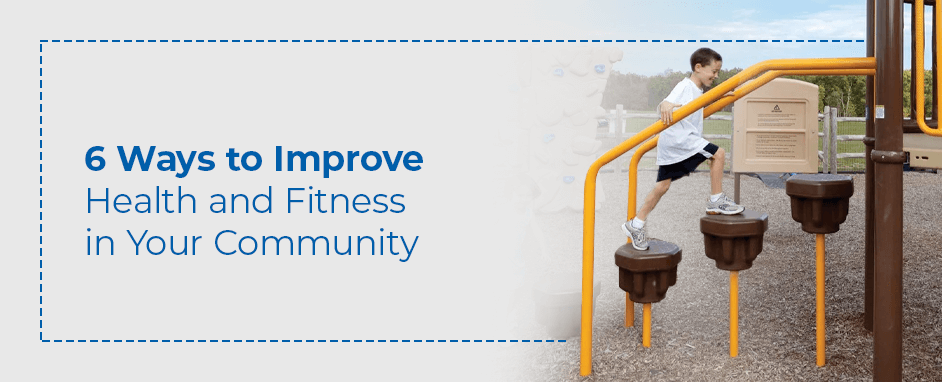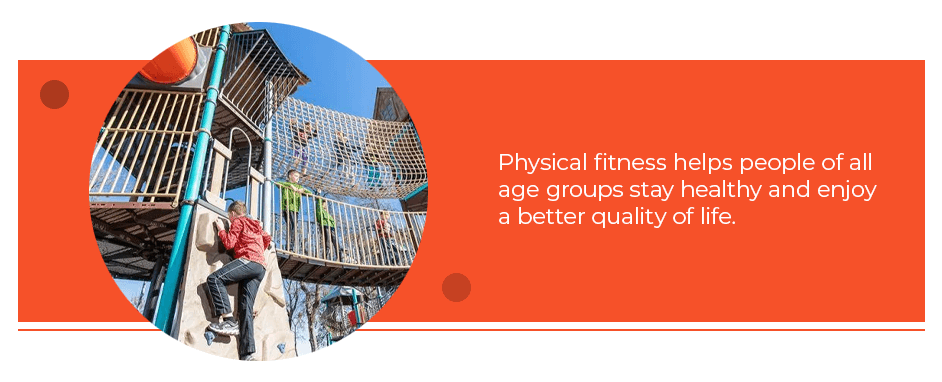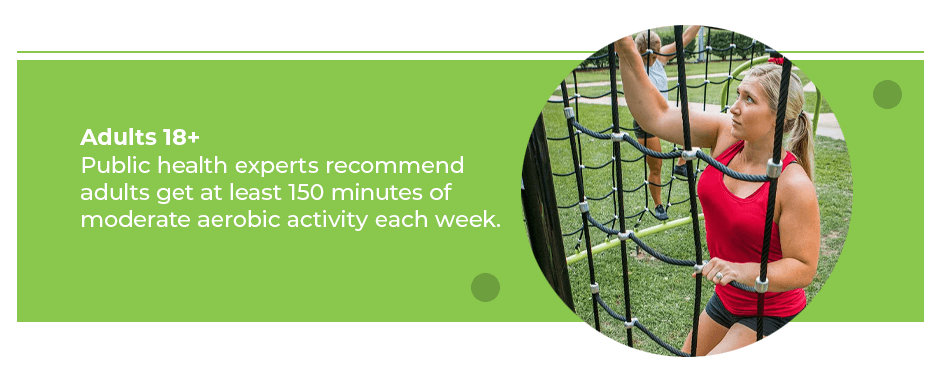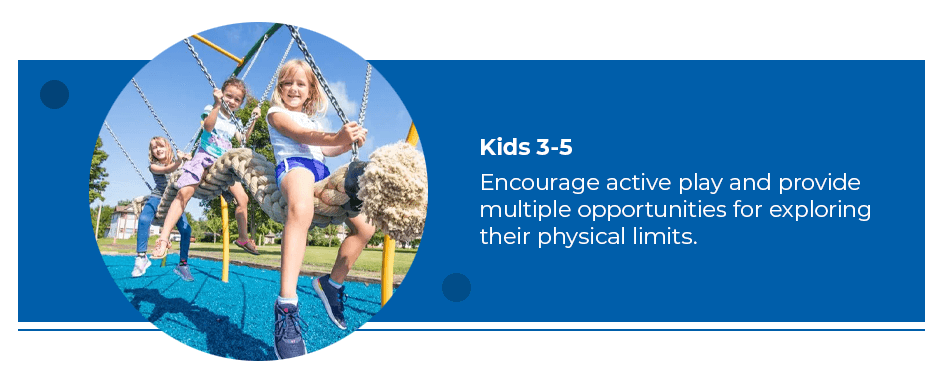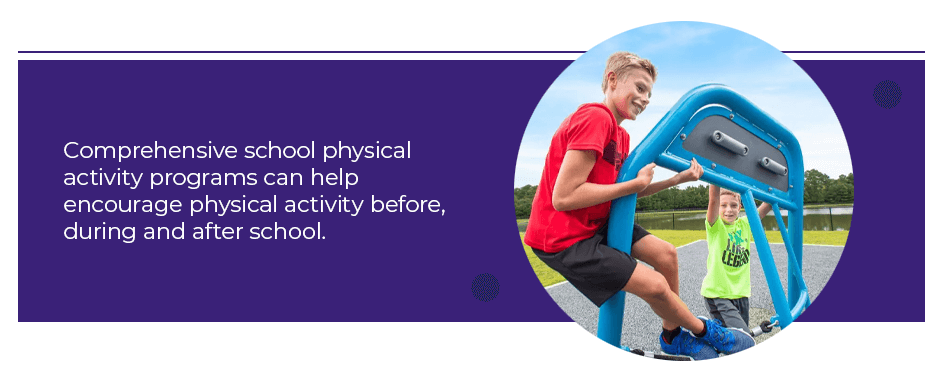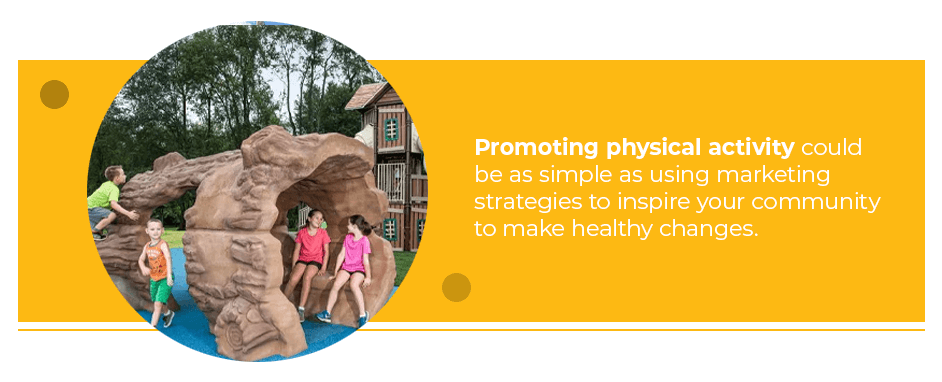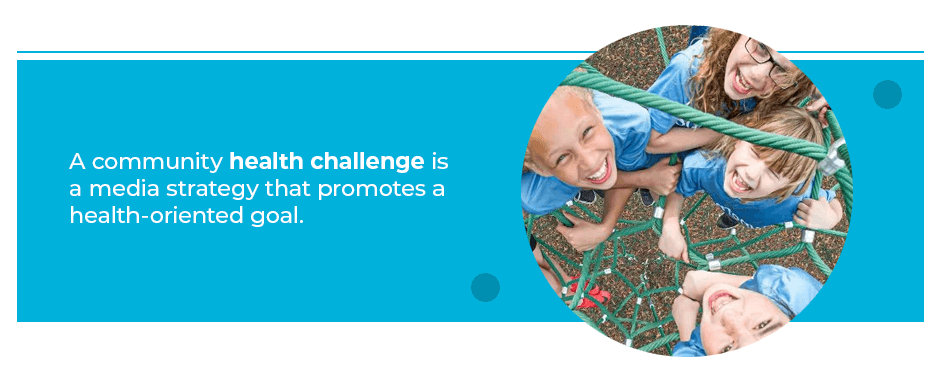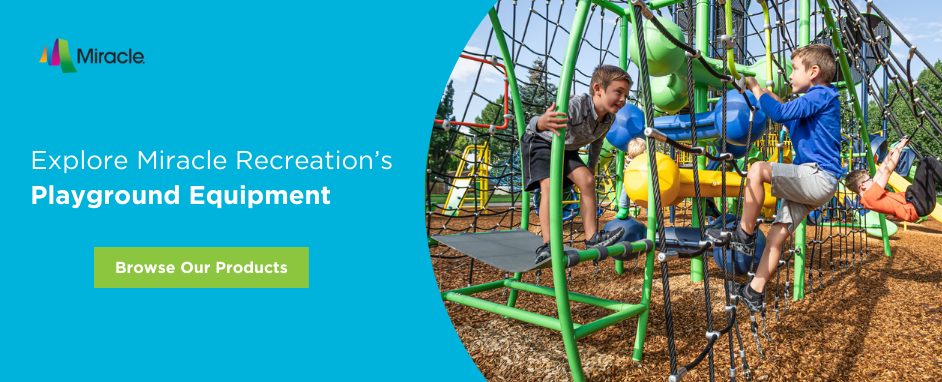6 Ways to Improve Health and Fitness in Your Community
Boosting your community’s health and fitness can be challenging, especially since many Americans do not get their physician-recommended amount of exercise. Inactivity and nutritional imbalances can lead to an unhealthy population with chronic illnesses and excess stress. While all communities are different, there are a few ways to improve public health in your community.
Read the full article or jump to a specific section:
- Physical Activity and Its Role in Community Health
- Physical Activity Guidelines
- Involving Multiple Sectors in Your Area
- 6 Strategies to Increase Physical Activity in the Community
- Creating a Community Park That Promotes Physical Activity
Physical Activity and Its Role in Community Health
An unhealthy population strains the community’s health organizations and reduces their overall quality of life. Community health should be a priority, but it can be challenging to figure out how to improve it. Learning how to promote physical activity in the community is a crucial part of promoting public health.
Preventing and Managing Chronic Conditions
According to the Centers for Disease Control, physical activity can help prevent chronic conditions. If you already have compromised health, regular exercise can help you manage your symptoms and make you feel better. Physical fitness helps people of all age groups stay healthy and enjoy a better quality of life.
- Heart disease: Regular exercise can improve overall heart health and help lower the risk of heart disease progressing. Likewise, exercising strengthens the heart muscle, preventing heart disease.
- Arthritis: Physical exercise can reduce the pain caused by arthritis while also improving physical function.
- Diabetes: Regular physical exercise can help insulin lower your blood sugar level more effectively.
- Asthma: Exercise can sometimes help reduce the frequency of asthma attacks. People with asthma should consult a doctor before making drastic changes to their exercise routine.
- Back pain: Low-impact aerobic fitness activities can increase your back strength, improve your range of motion and alleviate discomfort.
- Dementia: People who stay active lower their risk of cognitive impairment. Exercise allows more blood to flow through the brain and requires extra concentration and focus.
Improving Muscular Strength and Cognitive Function
Physical activity is critical for adults and children. It helps strengthen muscles, bones and cognitive function. You need these things for balance, flexibility, endurance and day-to-day living.
- Balance: Stronger muscles can help improve your balance, which reduces the risk of falls and injuries. Balance training is especially vital for older adults, for whom a fall could be risky.
- Memory: Getting active and increasing your heart rate can also benefit your brain by sending more blood and oxygen through it.
- Stress: Chronic stress can have several adverse effects on the brain. One of the benefits of exercise is the reduction of stress and feelings of depression and anxiety.
- Sleep: Regular exercise can even help you sleep better, boosting your health, energy and mood.
Physical Activity Guidelines
How much activity is enough? Most people are not getting the recommended amount of exercise in their daily lives. Kids and adults alike are spending more time indoors in front of electronics and less time being active.
Older Adults
Older adults and those with chronic conditions should consult a doctor before starting a new exercise routine. Any amount of activity is beneficial, but 150 minutes a week is ideal. Older adults should do some aerobic activity, balance training and muscle-strengthening activities.
Adults 18+
Public health experts recommend adults get at least 150 minutes of moderate aerobic activity each week, which could be as straightforward as walking briskly for 30 minutes five days a week. Adults should also participate in muscle-strengthening activities two days each week. These could include weightlifting at a gym or an at-home workout with exercises like pushups and situps.
Kids 6-17
CDC guidelines for older kids and teenagers suggest doing 60 minutes of physical activity each day, which is likely a lot more than they typically get. Your children may get some exercise during recess at school, but they will probably need more when they get home. Remember, they should also work out on the weekends. Include activities that strengthen muscles and bones. Trips to the park are an excellent way to give kids opportunities to run around and burn off excess energy.
Kids 3-5
Preschool-aged kids also need to be physically active throughout the day. Encourage active play and provide multiple opportunities for exploring their physical limits.
Involving Multiple Sectors in Your Area
Organizations, communities and government can affect the available opportunities for physical activity in the area. To improve community health, all sectors need to get involved. Consider all these departments when it comes time to launch new ways to promote physical activity.
- Parks and rec: The local parks and recreation department plays a crucial role in physical fitness. Workers are responsible for maintaining assets like sports fields, public pools, trails and playgrounds.
- Law enforcement: While police officers may be the last thing you think about for community health and fitness, they play a part by keeping neighborhoods safe. When people in the community are worried about crime, they are less likely to participate in outdoor activities.
- Public transportation: The transportation sector is responsible for implementing walking, biking and mass transit. All these options promote exercise — even public transit, since people have to walk to and from stops.
- Schools: Schools provide kids and teenagers with physical education and access to sports and athletic facilities.
- Employers: Employers also can play a part in community fitness. Adults have busy lives and sometimes need encouragement to keep up a healthy fitness routine. Employers and other private organizations can support community health by providing incentives to be active and providing equipment or hosting exercise programs.
- Health care: Doctors, nurses and other health providers can help advise people on how active they should be and how to safely exercise with any of their current conditions.
6 Strategies to Increase Physical Activity in the Community
Promoting public health should be a priority for government, public and private organizations.
1. Design Activity-Friendly Routes
Promoting walking and biking in your community can be easier with activity-friendly routes. When sidewalks, trails and bicycle lanes all easily connect with public transit stops, grocery stores, schools and workplaces, people will be more likely to choose to be active. Activity-friendly routes to popular destinations make travel safer, more accessible and promote walking and biking. Safe routes allow people of all ability levels to access their destinations while getting fresh air and exercise.
While creating safe routes to every major destination can seem like a daunting task, there are some routes to prioritize. Routes from residential neighborhoods to nearby schools and health care facilities are an ideal starting point. Then, create paths to parks and other destinations like grocery stores, neighborhoods and workplaces.
2. Develop Health, Nutrition and Exercise Initiatives at Schools
School-based health approaches help children start being active at an early age. Comprehensive school physical activity programs can help encourage physical activity before, during and after school.
- Health initiatives: Health centers in schools can help address students’ complex health needs. However, it can be complicated to implement these programs. Local organizations and community members must cooperate to facilitate collaboration between the school and health sectors. Health initiatives can also include classes or workshops for students to attend. Teach kids the relationship between nutrition, exercise and health.
- Nutrition education: Educating kids about nutrition is a crucial part of improving community health. If kids don’t learn about nutrition at home, school is the next best place. Kids should learn about the importance of a balanced diet and have access to healthy foods at lunchtime.
- Exercise programs: Exercise programs at schools can include various components, like physical education classes, recess and classroom activities. Comprehensive physical education classes help kids get the activity they need each day while also teaching them new skills and ways to exercise. Encouraging them to play during recess should also be a priority. Implementing after-school activities is another excellent option. Sports programs can also help kids stay active on the weekends during games or extra practices.
View Outdoor Fitness Equipment
3. Establish Community Gardens
Community gardens are open plots of land where residents can grow fruits, vegetables and flowers. Community gardens can promote healthy lifestyles in urban, suburban and rural areas. They encourage healthy eating, exercise and being out in nature. Participation in gardening activities can also improve well-being through reduced stress and increased social contact.
- Healthy food: Community gardens increase access to healthy food. People can enjoy growing and eating fresh produce. If there is any excess in the harvest, they can sell it or give it away to increase the availability of local, healthy food for everyone in the community.
- Physical exercise: Maintaining a garden requires a lot of physical activity, from digging out weeds to checking for pests and harvesting ripe produce. In many cases, access to community gardens results in more physical activity among youth and adults.
- Social benefits: Community gardens also create various social and emotional benefits. People who frequent the gardens will form social bonds with other community members. Families who garden together can also build stronger relationships. Some communities that plant and maintain public gardens have reduced food insecurity.
4. Launch a Community Health Challenge
Media campaigns can produce positive changes in populations, whether it’s encouraging people to buy wellness products or improve their active lifestyles. Promoting physical activity could be as simple as using marketing strategies to inspire your community to make healthy changes. Competitions and challenges get more people involved as they invite friends and family members to participate.
What Is a Community Health Challenge?
A community health challenge is a media strategy that promotes a health-oriented goal. Invite people to better themselves while also educating everyone about the benefits of doing so. It could be anything from challenging participants to reach a specific number of steps each day, train for a 5K or eat healthier. Read about examples of successful community health interventions.
Starting a Community Health Challenge
Starting a community health challenge requires support from area organizations. The best way to promote your message is to use many channels, such as mass media promotion and local organization support. Use newspapers, radio ads, bulletins and more to get the most awareness possible. Provide incentives, education and support for reaching the goals. Get as many people as possible involved and let them know why their engagement is valuable.
5. Provide Exercise Opportunities
Sometimes, people are interested in getting active and improving their fitness, but lack access to fun opportunities to work out. Parks, fitness centers and private organizations can open exercise classes or events to the public. Here are a few examples of exercise events:
- Yoga classes
- Cycling tours
- Dance workshops
- Walk-a-thons
- 5K runs
- Kickball games
These events can be specific to age groups or open to entire families. It’s a best practice to offer many different events spread out over the whole year. This variety will encourage people of all ages and ability levels to participate, while promoting a healthy lifestyle in the community.
6. Install a Community Playground
Community playgrounds offer a range of advantages. They provide a place for kids to develop emotional, cognitive, social and physical skills. Older community members can also benefit from these gathering spaces.
- Facilitates social and cognitive development: Community playgrounds are perfect places for kids to enjoy cooperative and independent play. As children interact with others, they learn how to communicate, take turns and resolve conflicts while developing friendships. Unstructured play also gives opportunities for decision-making and problem-solving. Kids have to choose which equipment to play on and what activities to participate in.
- Provides an emotional outlet: Children experience a wide range of emotions but sometimes don’t know how to regulate them. Active play can help kids process their feelings and release stress. Being out in nature also has emotional benefits and can reduce feelings of depression and anxiety.
- Boosts creativity: Playgrounds encourage and promote creativity through imaginative or pretend play. Kids can act out fantasy stories and use the equipment as inspiring props. They can pretend they’re knights, pirates or even animals and make up all kinds of stories. Themed playsets can make imaginative play even more exciting!
- Increases confidence: Community playgrounds should be safe places for kids to test their limits and improve themselves. Every time kids conquer the climbing wall or make it across monkey bars, they build confidence and learn what they can do. Kids will gain new skills and have higher self-esteem.
- Builds community: Community connections are as valuable for adults as they are for kids. Parks and playgrounds can be gathering places or a place to relax with friends, family and neighbors. Kids and adults alike can feel a sense of community.
- Encourages physical activity: Physical activity is a critical part of community health, and playgrounds are an excellent place to get exercise. Kids jump, climb and play on the equipment. Adults can also get exercise if there is a walking path or fitness area. All age groups can enjoy swing sets, too!
Creating a Community Park That Promotes Physical Activity
To create a community park, you’ll need help from a team of planners and playground experts. While the process can vary depending on your location and community, these are the general steps you’ll need to follow.
Choose a Location
First, you’ll need to identify the park’s location. Find a place that is safe, accessible and large enough to accommodate plenty of amenities and activities. There should be plenty of grass, open areas and trees that provide shade. Consider if there will be opportunities for expansion in the future, or if you will consistently have the same amount of land. That may affect your planning process and what activities you can provide.
Understand the Community
Next, you need to understand what the community needs in a park. Consider the demographics. Is the area primarily young couples with children, or older adults? Assessing the market will help you determine what your park needs to attract members of the community. The amenities you need to appeal to kids are very different from the ones you need for seniors and older adults.
Seek Support
Often, a significant undertaking like a new park requires community support and participation. Identify local associations, service clubs or influential leaders and see if they are willing to support your project. Any kind of support is helpful, whether it’s vocal, physical or financial. You could also do a local survey to see what people are more likely to support.
Include Various Activities
Providing multiple areas for different activities will attract the most people. Some amenities, like walking loops, fitness equipment and covered pavilions, are more likely to attract older adults. Sports fields and courts will attract kids and teenagers. Playground equipment will bring families with small kids. Here are some different elements you can include:
- Open sports fields with goals
- Baseball/softball diamonds
- Basketball courts
- Covered pavilion with grills
- Outdoor fitness equipment and pullup bars
- Comfortable seating areas
- Walking loop
- Dog park
- Hiking trails
- Playgrounds for kids 2-5
- Playgrounds for kids 5-12
Install Exciting Playground Equipment
Playground equipment is one of the primary components of almost every park. First, remember to choose a location in the park that is mostly level and safe for kids to roam around on. Prepare the land for the playground equipment by ensuring adequate drainage.
When it’s time for the equipment, partner with a trusted playground manufacturer. The equipment must meet all safety standards, including those for correct installation. While you brainstorm equipment options, also choose safety surfacing to install after you’ve built the playground, as a final step before opening your new site to the public.
Including various equipment is crucial. Install classic pieces of equipment like swings, slides, tunnels and climbers. Then, put in at least one unique thing that gets kids excited about coming to the park. Playgrounds should be so fun for kids that they forget they are exercising!
Don’t Forget Amenities
All parks also need site amenities, such as benches, picnic tables, trash receptacles and bike racks. These elements enhance the experience for every visitor. People need places to sit, relax and gather. Bike racks encourage physical activity by allowing people to bike there. Trash receptacles are vital for maintaining your park! Plenty of trash bins will encourage visitors to be responsible with their garbage and not leave it lying around.
Contact Us to Discuss Your Community Playground Vision
Miracle® Recreation is the leading producer of innovative and inclusive play spaces that encourage physical activity. We design our products to bring the thrill back into playgrounds! Partner with us for all your playground equipment needs. We have the planning tools you need to design the perfect playground for your space, budget and your community. Contact us today to learn more about starting a new playground for your area.
Related Posts:
Tips to Keep Your Kids Healthy After a Playground Trip
How Fitness Stations Help Decrease Obesity in Adults

